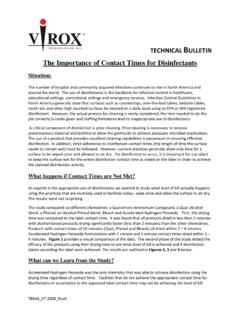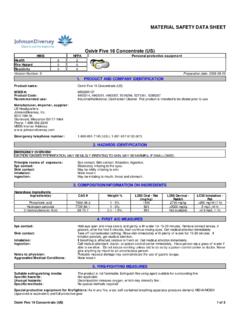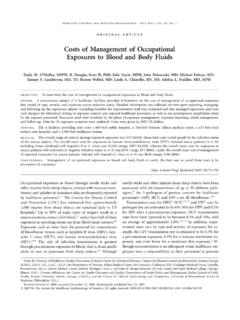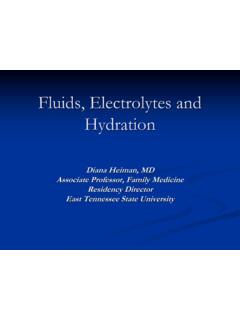Transcription of Cleaning and Disinfection Protocol for Enveloped Viruses
1 Cleaning and Disinfection Protocol for Enveloped Viruses This document has been developed in accordance with current applicable infection control and regulatory guidelines. It is intended for use as a guideline only. At no time should this document replace existing documents established by the facility unless written permission has been obtained from the responsible facility manager. This Protocol has been developed based on current practices for Cleaning and Disinfection of Enveloped Viruses . PREFACE Enveloped Viruses are Viruses that possess an envelope or outer coating that is composed of a lipid layer (fat-like substance that is water insoluble).
2 The envelope is needed to aid in attachment of the virus to the host cell. Loss of the envelope results in loss of infectivity. The mode of transmission for Enveloped Viruses is characterized by the specific virus; however, the most common routes are via indirect or direct contact of infectious virus particles, contact with or inhalation of respiratory droplets. Some Enveloped Viruses may also be transmitted by airborne transmission. Enveloped Viruses are easily inactivated by routine surface Cleaning and Disinfection .
3 The following table provides examples of Enveloped Viruses and Mode of Transmission of concern for Healthcare settings. Virus Mode of Transmission Infective Material Coronavirus (ex, SARS-CoV) Direct and Indirect Contact, Droplet Respiratory secretions Cytomegalovirus (CMV) Sexual contact, Direct Contact Blood, exposure to mucosal contact with infected tissues, secretions (saliva, breast milk, semen etc), excretions Ebola Virus Direct and Indirect Contact, Possibly by airborne if pneumonia present Blood and body fluids, Respiratory secretions Epstein-Barr Virus Direct contact Oropharyngeal route via saliva, blood products Hantavirus Inhalation of infected particles from Rodent urine or feces Urine and Feces Hepatitis B Direct (mucosal or percutaneous exposure to infective body fluids) and Indirect contact Blood and body fluids Hepatitis C Direct contact (sexual or percutaneous)
4 Blood and body fluids Herpes Simplex (ex, HS-1, HS-II) Direct Contact Skin or mucosal lesions, body secretions and excretions Herpes zoster (Varicella-Zoster) Airborne, Direct and Indirect contact Vesicle fluid , respiratory secretions Human Immunodeficiency Virus (HIV) Mucosal or percutaneous exposure Blood and body Fluids Influenza (including A, B, Avian) Large droplets, Direct and Indirect contact, possibly airborne Respiratory secretions Lassa Virus (Lassa Fever) Direct and Indirect contact (possibly airborne if pneumonia is present) Blood and body fluids, respiratory secretions, possibly urine and stool Marburg Virus Direct and Indirect contact (possibly airborne if pneumonia is present) Blood and body fluids, respiratory secretions Monkeypox Virus Direct Contact (person-to-person) Vesicle secretions Measles (Morbillivirus)
5 Airborne Respiratory secretions Mumps (Rubulavirus) Large droplets and Direct contact Saliva Parainfluenza virus Direct and Indirect contact, large droplets Respiratory secretions Respiratory Syncytial Virus (RSV) Direct and Indirect Contact, Large droplets Respiratory secretions Cleaning and Disinfection Protocol for Enveloped Viruses PREPARATION Transmission of Enveloped Viruses can be attributed to direct and indirect contact, respiratory droplets and airborne transmission.
6 Appropriate personal protection should be taken for those responsible for the decontamination of a room or area. Appropriate bio-security practices should be applied, including limiting the amount of aerosols generated and disturbance to dust / soil in the area to be cleaned and disinfected. PROTECTIVE BARRIERS 1. Disposable gloves. Gloves should be changed as required, , when torn, when hands become wet inside the glove and between patient rooms. 2. Household gloves can be worn, but they must be discarded when the Cleaning is complete.
7 3. Protective Eye wear (goggles, face shield or mask with eye protection) 4. Masks (N95) 5. Gowns PRODUCTS Accelerated Hydrogen Peroxide Surface Disinfectant (sold as 7% Virox 5 Concentrate, Virox 5 Ready-To-Use and/ or Virox 5 Wipes, 7% PerCept Concentrate, PerCept RTU or PerCept Wipes, 7% Accel Surface Cleaner Disinfectant Concentrate, Accel RTU or Accel Wipes) and Accelerated Hydrogen Peroxide Tuberculocidal Surface Disinfectant (sold as Oxivir Tb RTU, Oxivir Tb Wipes, Carpe Diem Tb RTU, Carpe Diem Tb Wipes, Accel TB RTU or Accel TB Wipes) 1.
8 Preparation of solution - Pre-mix and label from a controlled location 7% AHP Concentrate at a ratio of 1:16 ( AHP). 2. Place mixed solution in either a labeled - flip top 1 Litre bottle or a small hand bucket. 3. AHP RTU is ready to use ( AHP). 4. AHP Wipes are ready to use ( AHP). PRODUCT GERMICIDAL EFFICACY All products listed above are based upon Accelerated Hydrogen Peroxide and have a Sanitizing claim and a Bactericidal claim against Vegetative Bacteria including MRSA and VRE. Additionally, the products carry a General Virucide Claim against Poliovirus Type 1, Sabin Strain, which includes inactivation of both Enveloped and non- Enveloped Viruses .
9 In addition to the General Virucide Claim, Accelerated Hydrogen Peroxide has been proven to show efficacy against HIV, Human Coronavirus, Human Rhinovirus, Human Rotavirus, Canine Parvovirus, Feline Calicivirus (Norovirus) and the H3N2 strain of Avian Influenza A. SUMMARY OF PROCEDURES Apply solution to either surface or to cloth. Clean all horizontal surfaces in the room ensuring that the cloth is changed when soiled. Place used cloth in a marked plastic-lined waste receptacle. Disinfect all horizontal surfaces of the room paying special attention to hand contact and frequently touched surfaces by reapplying the AHP Solution and allowing for a 5-minute contact time.
10 If using cloth & bucket method, once room has been cleaned discard all unused Cleaning solution before proceeding to the Disinfection step. Allow to air dry or wipe dry if surfaces are still wet after the 5-minute contact time. Periodic rinsing of soft surfaces such as vinyl or Naugahyde is suggested. Bathrooms within a room should be cleaned last. Cleaning and Disinfection Protocol for Enveloped Viruses Recommended Procedures for Housekeeping Activities Detailed Activity. 1. Gather all equipment, Cleaning solutions and materials required to clean the room.











